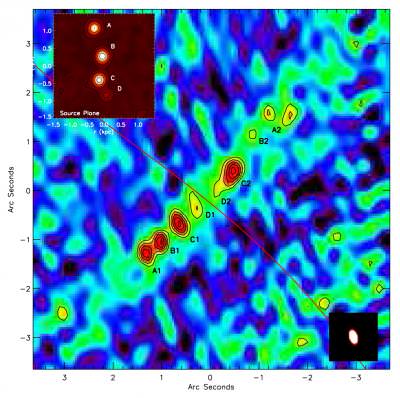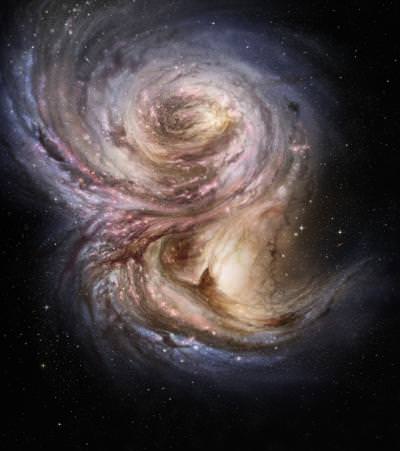[/caption]
Looking back in time – and through a gravitational lens – astronomers found evidence that galaxies in the early Universe went through a “growth spurt” of rapid and vigorous star formation. A distant galaxy, known as SMM J2135-0102 is making new stars 250 times faster than the Milky Way. Due to the amount of time it takes light to reach Earth the scientists observed the galaxy as it would have appeared 10 billion years ago – just three billion years after the Big Bang.
“This galaxy is like a teenager going through a growth spurt,” said Dr. Mark Swinbank from Durham University, lead author of a new paper published in Nature. “We don’t fully understand why the stars are forming so rapidly but our results suggest that stars formed much more efficiently in the early Universe than they do today. Galaxies in the early Universe appear to have gone through rapid growth and stars like our sun formed much more quickly than they do today.”
SMM J2135-0102 was found using the Atacama Pathfinder Experiment (APEX) telescope, which is operated by the European Southern Observatory (ESO). Follow-up observations were carried out by combining the natural gravitational lens of nearby galaxies with the powerful Submillimeter Array telescope based in Hawaii to magnify the galaxy even further.

“To a layperson, our images appear fuzzy, but to us, they show the exquisite detail of a Faberge egg,” said Steven Longmore of the Harvard-Smithsonian Center for Astrophysics (CfA).
“The magnification reveals the galaxy in unprecedented detail, even though it is so distant that its light has taken about 10 billion years to reach us,” said Swinbank. “In follow-up observations with the Submillimeter Array telescope we’ve been able to study the clouds where stars are forming in the galaxy with great precision.”
They found four discrete star-forming regions within the galaxy, and each region was more than 100 times brighter than star-forming regions in the Milky Way, such as the Orion Nebula, and estimate that the observed galaxy is producing stars at a rate equivalent to 250 suns per year.
“The star formation in this galaxy’s large dust clouds is unlike that in the nearby Universe,” said co-author Carlos De Breuck from ESO. “However, our observations suggest that we should be able to use underlying physics from the densest cores in nearby galaxies to understand star birth in these more distant galaxies.”
Their results provide new insight into a critical time during the Universe’s history. SMM J2135-0102 is seen at the epoch when the majority of all stars were born, and therefore when many of the properties of nearby galaxies were defined. By studying it and other distant galaxies in the young Universe, astronomers hope to learn about the history of the Milky Way and other nearby galaxies.


For anyone who may be interested, the research paper can be downloaded from here (PDF).
Assuming expansion of space is accelerating, the early universe had to have been much much smaller and therefor much more active, i.e. the material for star making and galaxy formation would be much closer and denser and subsequent collisions of the newborn galaxies would be happening more frequently.
Time is not constant. Perhaps everything appears to happen faster at that distance.
If time is not constant, how can space be constant?
Or are you saying that time goes with the flow when space is influenced by mass.